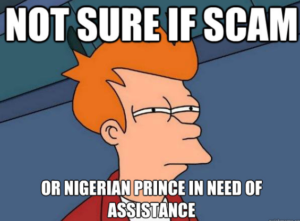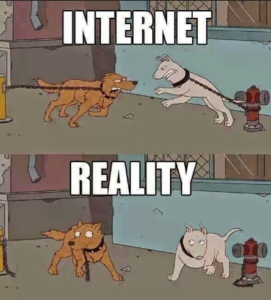Here we are, communicating with one another through a screen. Some of you are reading this on your smartphone, others on your tablet, and some of you are on a desktop or laptop computer. It’s a daily method of communication – looking at a screen to see what someone else has “said.” This is amazing, of course. Figuratively, our world is smaller than ever. We can write something on a blog or a social media site and, instantly, someone in another part of the world can read and respond. Nearly every thought and feeling anyone has can be broadcast and discussed in real-time. Advertisers can create campaigns that show up in newsfeeds and on the side bar of online email accounts, like Yahoo. It is amazing. But, how much of it is real?
USA.gov has a page on its website that provides tips for remaining safe online due to the level of false information and activity. They advise about fake auction sites and scam emails. I mean, we all have that rich, royal, Nigerian relative we’ve never met who wants to give us their entire kingdom for helping them convert $100 into a money order, right? MTV’s Catfish is an entire series based on people who have been taken in romantically by someone pretending to be an entirely different person. People can say anything they want behind the protective curtain of a screen.
So, what has this done to the way we communicate with one another? Do we stop really seeing one another as people on this platform? Do we all think nothing and no one is real online? In many forums, people may use a fake name, upload fake pictures (or not use pictures at all), and invent intricate back stories about lives they have never lived. In an online environment, users are offered a cloak of invisibility (Suler, 2004), and they embrace this opportunity. People freely tell others things like, “Kill yourself!” – as though they are not speaking to another human.
Advertisers photoshop images until the people in the pictures are totally different. Everything is fabricated. We cannot trust the words of what may or may not be a “real” person, and we cannot believe our eyes. All of this means there is a strain on online communications between people and advertisers, as well as online communications between people. Fake pictures, false profiles, manufactured bravado.
In a world where online communication and interaction are part of many of our daily lives, how do we get back to something real? How do we inject some actual humanity into our human interactions – from a personal as well as a marketing perspective?
References
Suler, J. (2004). The online disinhibition effect. Cyber Psychology & Behavior. Retrieved from http://www.academia.edu/3658367/The_online_disinhibition_effect





3 Responses to Is Anything Real Online?